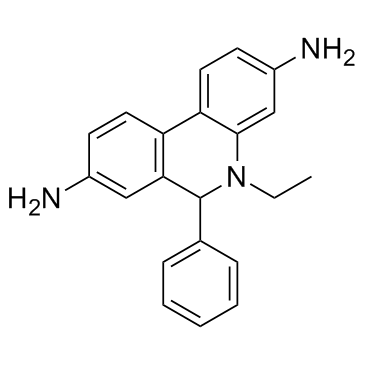Dihydroethidium (Hydroethidine) (Synonyms: DHE) |
| Catalog No.GC30025 |
Dihydroethdium(Hydroethidine) (DHE) oxidation is commonly used as a method for monitoring cellular production of "reactive oxygen species (ROS)".
Products are for research use only. Not for human use. We do not sell to patients.

Cas No.: 104821-25-2,38483-26-0
Sample solution is provided at 25 µL, 10mM.
Dihydroethdium(Hydroethidine) (DHE) oxidation is commonly used as a method for monitoring cellular production of "reactive oxygen species (ROS)". Usually changes in DHE florescence due to oxidation in cells and tissues are measured by microscopy, flow cytometry and occassionaly by HPLC analysis [1]. Dihydroethdium is a hydrophobic uncharged compound that is able to cross extra- and intracellular membranes and, upon oxidation, becomes positively charged and accumulates in cells by intercalating into DNA, primarily by electrostatic interactions with DNA phosphate groups and further via hydrophobic interactions [2]. Its oxidation by different oxidizing systems has been used increasingly for fluorescent analysis of ROS output in cells and tissues. Dihydroethdium -derived red fluorescence observed with rhodamine filter (excitation 490; emission 590 nm) was attributed to ethidium compound formation, a two-electron oxidation product, and the red fluorescence was obtained more specifically with superoxide-generating systems (xanthine or glucose oxidase) rather than with oxidants such as hydrogen peroxide, peroxynitrite, or hydroxyl radical (generated by the Fenton reaction) [3,4].
Detection of ROS production in the liver tissues [5]
The levels of ROS production in the liver tissues were determined by dihydroethidium (DHE) staining. Frozen sections of liver tissues in each group (5-µm-thick) were prepared and incubated with DHE (7.5 mM,) for 30 min in the dark at 37 °C. After staining with DAPI, the sections were observed using a fluorescence microscope.
References:
[1]. Wagner B A, Buettner G R. Quantitative Changes in Dihydroethidium (DHE) Oxidation Products from Isolated Mitochondria While Respiring on Select Substrates and the Effects Mitochondrial Inhibitors Commonly Used in Bioenergetic Profiling[J]. Free Radical Biology and Medicine, 2016, 100: S31.
[2]. Garbett N C, Hammond N B, Graves D E. Influence of the amino substituents in the interaction of ethidium bromide with DNA[J]. Biophysical journal, 2004, 87(6): 3974-3981.
[3]. Benov L, Sztejnberg L, Fridovich I. Critical evaluation of the use of hydroethidine as a measure of superoxide anion radical[J]. Free Radical Biology and Medicine, 1998, 25(7): 826-831.
[4]. Biemond P, Swaak A J G, Beindorff C M, et al. Superoxide-dependent and-independent mechanisms of iron mobilization from ferritin by xanthine oxidase. Implications for oxygen-free-radical-induced tissue destruction during ischaemia and inflammation[J]. Biochemical Journal, 1986, 239(1): 169-173.
[5]. Zheng J, Chen L, Lu T, et al. MSCs ameliorate hepatocellular apoptosis mediated by PINK1-dependent mitophagy in liver ischemia/reperfusion injury through AMPKα activation[J]. Cell death & disease, 2020, 11(4): 1-19.
Average Rating: 5 (Based on Reviews and 37 reference(s) in Google Scholar.)
GLPBIO products are for RESEARCH USE ONLY. Please make sure your review or question is research based.
Required fields are marked with *




